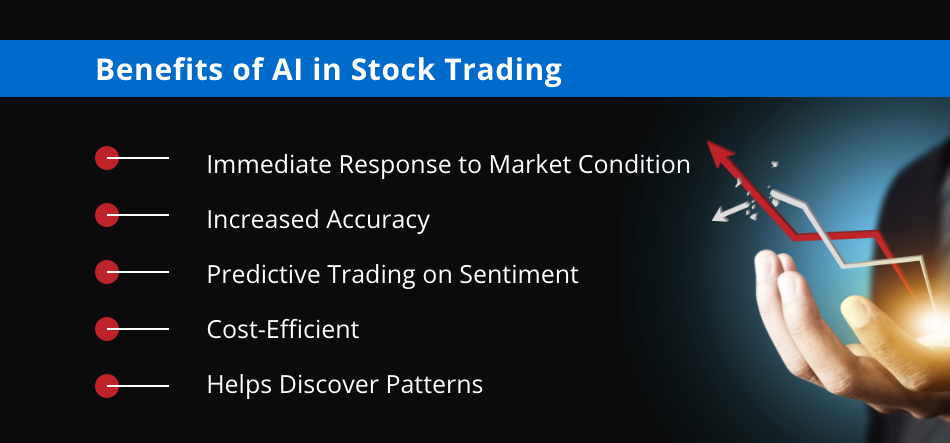20 Pro Ideas On Deciding On AI Stock Picker Platform Sites
20 Pro Ideas On Deciding On AI Stock Picker Platform Sites
Blog Article
Top 10 Tips For Assessing The Integration Of Ai Stock Predicting Trading Platforms
Integrity and compatibility are key elements to be considered when evaluating AI software for stock forecasting and analyzing trading platforms. A platform that seamlessly integrates with your existing tools and systems as well as workflows will greatly improve efficiency and productivity. Here are the top 10 tips to evaluate the compatibility and integration of these platforms:
1. Check Brokerage Integration
Platform integration with preferred brokers or trading accounts: Make sure whether the platform integrates with your chosen brokerage or account.
Trade Execution: Check if the platform permits direct trade execution through the integrated broker.
Account synchronization. Find out if the platform permits you to sync your account balances in real-time, as well as positions and transactions.
2. Check API for Availability
API access: Ensure the platform has an API (Application Programming Interface) that lets developers create customized applications and streamline workflows.
API documentation: Check if the API is well-documented and includes clear examples and use cases.
Rate Limits: Verify the API's rate limits to confirm they're reasonable and will handle your expected usage.
3. Assess Third-Party Integration
Popular tools: Check if your platform is compatible with the most popular tools like Google Sheets or Excel.
Import and export of data. Check that your platform can export/import easily from/to other tools.
Extensions/Plugins: Determine if your platform supports extensions or plugins to add features.
4. Test Compatibility Using Operating Systems
Desktop compatibility: Make sure your platform is compatible with your OS of choice (Windows, macOS or Linux).
Mobile compatibility: Find out whether the platform has a mobile app for iOS and Android.
Web-based accessibility: To enhance flexibility, make sure that the platform's interface can be accessed through an internet browser.
5. Evaluate the capabilities of data integration
Data sources. Ensure the platform has several data integrations (e.g. data providers for social media, market sentiment and news feeds).
Real-time data streams: Verify that the platform has the ability to incorporate real-time information for up-todate analyses.
Import historical data - Check whether your platform allows you to integrate historical data into your backtesting software or analytical software.
6. Evaluate cloud and on-premise compatible
Cloud-based platforms: Make sure that the platform is accessible from anywhere with an internet connection.
Solutions on-premise: If you prefer to deploy on premises, check that the platform you are using supports it.
Hybrid options: Check whether the platform has an hybrid model that combines cloud capabilities and on-premise ones.
7. Make sure to check for Cross Platform Synchronization
Device synchronization. Check that the platform is synchronized with settings and data across the devices (desktops/laptops/mobiles/tablets).
Real-time updates: Verify if changes made on one device are immediately reflected on others.
Check the platform to see whether it permits access to data or functions when you're offline.
8. Assess the Compatibility of Trading Strategies
Automated or algorithmic trading: Ensure that the trading platform supports these strategies.
Custom indicators - Make sure to check if the platform permits the use of customized scripts and technical indicators.
Backtesting strategies Check for yourself if the trading platform permits backtesting using historical data.
9. Review Security and Compliance
Data encryption: Ensure the platform is using encryption to protect information in transit as well as at rest.
Authentication : Check that the platform is compatible with safe authentication methods (e.g. 2-factor authentication).
Regulative compliance - Determine if the your platform is compliant with relevant regulations, e.g. GDPR. FINRA. SEC.
10. Test Scalability and Performance
Scalability is essential. The platform must be able to handle the ever-growing amount of data, and numbers of users.
Performance under load - Verify that the platform continues to respond in conditions of high market volatility.
Utilization of resources - Make sure that the platform efficiently uses system resources such as CPU, memory or bandwidth.
Bonus Tips
User feedback: Make use of user testimonials to evaluate the platform integration capabilities.
Free trial period: You are able to use a demo or free trial to test the platform's compatibility with your existing workflows and applications.
Customer Support: Make sure the platform offers a solid assistance to help with integration problems.
These tips will aid you in evaluating the ability to integrate seamlessly and with ease AI trading platforms which predict and analyze stock prices. They can also improve the performance of your trading. Take a look at the top official statement for incite for website advice including ai trading, ai investing platform, ai trade, stock ai, ai chart analysis, ai for investment, ai stock picker, trading with ai, using ai to trade stocks, ai for stock trading and more.
Top 10 Tips For Assessing The Latency And Speed Of Ai Trading Platforms
Speed and latency is an important factor to consider when evaluating AI stock prediction/analyzing trading platforms. This is particularly true for high-frequency traders, algorithmic traders, as well as active traders. Even milliseconds delay can have a negative impact on trading execution. Here are 10 top ways to measure the speed and the latency of the platforms.
1. Real-time data feeds: How to assess them
Speed of data delivery - Make sure that the platform is able to deliver real-time information with a minimal delay (e.g. an under-millisecond latency).
Data source proximity: Determine whether the server of the platform is situated near major exchanges to reduce time to transmit data.
Data compression: Determine whether the platform is using effective data compression techniques to speed up data delivery.
2. Test Trade Speed of Execution
The time it takes to process your order is the time that your order will be processed and executed through the platform.
Direct market access (DMA) Make sure the platform offers DMA that lets orders be sent directly to the exchange, without intermediaries.
Examine the execution reports to determine if they include timestamps of order confirmation fill, submission, and confirmation.
3. Examine the Platform's Responsiveness
User interface (UI speed): Check how fast the system responds to inputs for example, clicking buttons or loading charts.
Chart updates - Verify that the charts are updated in real time and without any lag.
Performance of mobile apps. If you are using an app designed for mobile make sure it is performing as quickly and smoothly as the desktop version.
4. Check for Low Latency Infrastructure
Servers' locations The platform must use low-latency, high-speed servers that are located close to major financial hubs or exchanges.
Co-location services: Find out if the platform offers colocation services that allow you to host your trading algorithm on servers close to the exchange.
High-speed Networks: Confirm the platform's utilization of fiber-optic, high-speed network or other technologies that have low latency.
5. Check the backtesting speed and simulation speed.
Processing of historical data: See the speed at which the platform processes and analyzes historical data for backtesting.
Simulation latency: Ensure that the platform can simulate trading in real time without any noticeable delays.
Parallel processing (or distributed computing) Learn whether a platform makes use of the concept of parallel processing or distributed processing in order to accelerate complex calculations.
6. Calculate the API Latency
API response time The API response time is the rate at the rate at which an API platform responds to requests.
Rate limits. Check to see if there are reasonable limits for the API. This can assist in avoiding delays in high-frequency transactions.
WebSocket Support: Verify whether the platform supports WebSocket protocols for streaming data in real time and at a low latency.
7. Test Platform Stability under load
High-volume trading: Simulate high-volume trading scenarios to see if the platform remains steady and responsive.
Market volatility: Test the platform during periods of high market volatility to make sure it is able to handle the rapid price changes.
Test for stress: Check whether your platform offers tools for stress-testing strategies under extreme circumstances.
8. Review Connectivity and Network
Internet speed requirements: Make sure that your connection is at the recommended speed for your platform.
Redundant connection: Check to see if there are redundant connections available.
VPN latency. Check to see if you're using the VPN in the event that this causes latency.
9. Make sure to look for speed optimization features
Pre-trade Analyses: Ensure that the platform includes pre-trade analyis to optimize order processing and execution speed.
Smart order routing (SOR) Check whether the platform utilizes SOR to find the fastest and cost-effective execution venues.
Monitoring latency: Verify that the platform offers tools to analyze and monitor latency in real time.
Examine the feedback of users and benchmarks
Reviews from users: Search for feedback from users on the platform to gain an understanding of the speed and latency of the platform.
Third-party benchmarks from third-party. You can find benchmarks from independent sources, or reviews that compare a platform's speed with other platforms.
Case studies: Determine whether a platform offers cases studies or testimonials which highlight the features that are low-latency.
Bonus Tips
Utilize the trial period or free demo period to test your platform’s speed and latency in real-world conditions.
Customer support: Check to see if the platform provides assistance for issues with latency or optimization.
Hardware requirements. Make sure the platform is compatible with the hardware you are using like high-performance computers.
These tips will assist you in evaluating the speed of AI trading platforms that predict/analyze stock prices. It will allow you to pick a trading platform that is the most suitable for the requirements of your trading and eliminates any delays. Low latency, especially for algorithms and high-frequency trading, is vital. Even small delays can greatly impact profits. Take a look at the recommended stocks ai advice for blog info including free ai stock picker, ai stock price prediction, ai in stock market, best ai stocks to buy now, ai investment tools, stock trading ai, best ai stock prediction, ai options, ai for trading stocks, invest ai and more.